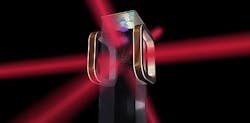Researchers from the NASA Jet Propulsion Laboratory (JPL; Pasadena, CA) have designed and built a Cold Atom Lab (CAL) to help answer questions of general relativity and quantum mechanics. The sophisticated setup includes four optical switches and shutters from Leoni's Fiber Optics Business Unit (https://www.leoni-fiber-optics.com/en/).
RELATED ARTICLE: Laser light "dresses" ultracold atoms in BEC, revealing new types of scattering
The CAL mission successfully launched to the International Space Station (ISS) in May 2018. With an instrument that's about the size of a small refrigerator, it will generate temperatures of 100 pK, one-tenth of a billionth of a degree above absolute zero--even colder than the average temperature of deep space. By means of laser cooling, atoms move very slowly and clouds of ultracooled atoms called Bose-Einstein Condensates (BECs) are produced.
On Earth, freely evolving BECs are dragged down by the pull of gravity, and can typically only be observed for a fraction of a second. But in the microgravity environment of the space station, each freely evolving BEC can be observed for up to 10 seconds, which is longer than what is possible with any other existing BEC experiment.
CAL is a multi-user facility that supports many investigators studying a broad range of topics. One of the first experiments at CAL is led by Eric Cornell, noble-prize winner and physicist at University of Colorado. Cornell and his team will investigate particle collision and how particles interact with one another. The various tests by leading scientists will be remotely conducted from the Earth.
By this, researchers expect to get new insights into the world of quantum mechanics and might clarify how gravity and space time are woven through the quantum realm. The results of the experiments planned so far may lead to improved technologies including sensors, quantum computers and atomic clocks used in spacecraft navigation. The CAL mission is scheduled for one year but can be extended up to five years.
JPL and Leoni partnered up in 2013 to realize parts of this project and managed to solve the according challenges of short switching times, high reliability and on board safety together.
"We are very happy Jet Propulsion Laboratory gave us the chance to prove our know-how for sophisticated and reliable technical solutions. After being part of proofing the existence of gravitational waves in 2016 this might be another groundbreaking opportunity for Leoni regarding high-end applied basic research and consequentially created new technologies," says Bruno Fankhauser, member of the board of directors of Leoni with responsibility for the Wire & Cable Solutions Division.
The FiberSwitch products by Leoni are essential components of the laser cooling process. They help to switch the laser sources to control and slow down the atoms during the cooling process, and then allow for short light pulses that detect the atoms. In that manner, an observation period of up to 10 seconds can be achieved to help further reveal fundamental secrets of our universe at the quantum level.
Once atom clouds are prepared in their ultracold states, they are very sensitive to any stray light where even a single photon could knock an atom out its desired state. To this end, the Leoni switches were used because they can shutoff atom trapping laser throughput to 80 dB or more. They also had to be vibration stable and consist of flame-retardant buffers for safety reasons, polarization maintaining with low polarization dependent losses, and provide ultralow back reflection.
SOURCE: Leoni Fiber Optics; https://www.leoni-fiber-optics.com/en/news/details/leonis-optical-switches-as-part-of-the-coolest-spot-in-the-solar-system/

Gail Overton | Senior Editor (2004-2020)
Gail has more than 30 years of engineering, marketing, product management, and editorial experience in the photonics and optical communications industry. Before joining the staff at Laser Focus World in 2004, she held many product management and product marketing roles in the fiber-optics industry, most notably at Hughes (El Segundo, CA), GTE Labs (Waltham, MA), Corning (Corning, NY), Photon Kinetics (Beaverton, OR), and Newport Corporation (Irvine, CA). During her marketing career, Gail published articles in WDM Solutions and Sensors magazine and traveled internationally to conduct product and sales training. Gail received her BS degree in physics, with an emphasis in optics, from San Diego State University in San Diego, CA in May 1986.
